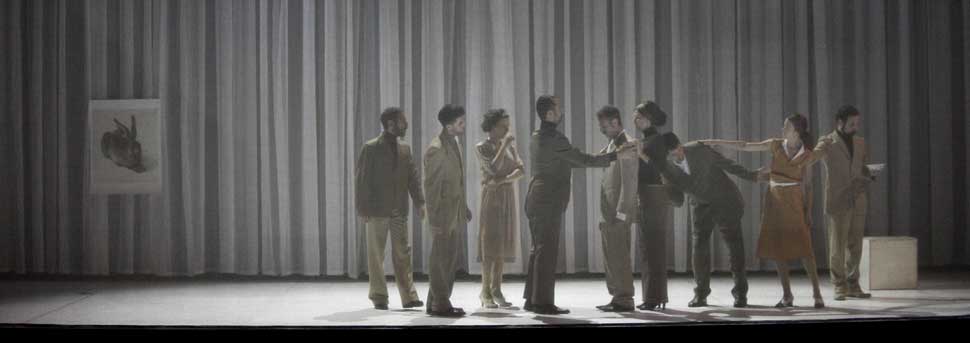by Romeo Castellucci
direction, set, costumes and lights Romeo Castellucci
music Scott Gibbons
texts by Claudia Castellucci and Romeo Castellucci
with Rascia Darwish, Gloria Dorliguzzo, Luca Nava, Stefano Questorio, Sergio Scarlatella
and with Mauro Barbiero, Simonetta Gamberini, Roberta Raimondi
collaboration to set design Massimiliano Scuto
light designer assistant Fabiana Piccioli
set construction director Massimiliano Peyrone
stage sculptures, prosthesis and machinery Giovanna Amoroso, Istvan Zimmermann
costumes realization Laura Dondoli
assistance to sound composition Asa Horvitz
stage technicians Lorenzo Martinelli, Michele Loguercio, Filippo Mancini
sound technician Matteo Braglia
lights technician Danilo Quatrociocchi
production Benedetta Briglia, Cosetta Nicolini
promotion and communication Valentina Bertolino, Gilda Biasini
administration Michela Medri, Elisa Bruno, Simona Barducci
administration advice Massimiliano Coli
Socìetas Raffaello Sanzio
in coproduction with Théâtre de la Ville with Festival d’Automne à Paris; Théâtre de Vidy-Lausanne; deSingel International Arts Campus /Antwerp; Teatro di Roma; La Comédie de Reims Maillon, Théâtre de Strasbourg / Scène Européenne; La Filature, Scène nationale-Mulhouse, Athens Festival 2015, Le Volcan, Scène nationale du Havre; Adelaide Festival 2016 Australia; Peak Performances 2016, Montclair State-USA
with the participation of Festival TransAmérique-Montreal
thanks for the collaboration to Comune di Senigallia- Assessorato alla Promozione dei Turismi, Manifestazioni / AMAT
music tracks
“O Heavenly King” composed by Alexander Knaifel, performed by Oleg Malov and Tatiana Melentieva. From the album: “Alexander Knaifel: Shramy Marsha, Passacaglia, Postludia” Megadisc, 1996
“Wade In the Water” composed by John Wesley Work II and Frederick J. Work, performed by Empire Jubilee Quartet. From the album: “Take Me To The Water” Dust-to-Digital, 2009
Running time 1 hour and 15 minutes
With his challenging and destabilizing theatre, Romeo Castellucci is one of the protagonists of the avant-guarde scene. During his career, he was awarded with several prizes, among which a Leone d’Oro by Venice Theatre Biennale and an ad honorem graduation in Music and Theatre by the University of Bologna.
After his discussed Sul concetto di volto nel figlio di Dio, Castellucci focuses here on another central figure of western religious culture, Moses.
This work transfigures the various moments of Moses’ life as they are narrated in the Book of Exodus. There is something about the events of this man’s life that has to do with the substance of our times. As with Michelangelo’s Moses – described in the text that Freud dedicated to this work – the prophet of monotheism is presented here as a man, forced to react when faced with the difficulties that this God –without name and without image- wants him to face: the abandonment of his newborn body in the waters of the Nile, the mystery of the burning bush in which the blinding splendour of glory of YHWH – in the kabod – manifests, and the 40 days on Mount Sinai where he received the tables of the law just to discover, on the way back, the golden calf erected and venerated by his people.
The character of Moses is dissolved across the scenes, disregarding biographical narration to extend itself over concepts, sentiments and premonitions of a revelation that acts now, in our time. Moses is brought closer to the spectator’s gaze, embodied in every element of the performance which is conceived in tableaux and fragments; psychic vibrations that emerge like ripples across lifetime at once routine and obscurely perceived as an exile.
The title evokes the famous spiritual song by the American slaves who identified themselves with the Judaic people, presage of their return to Africa. The Israelites, able to escape their exile in Babylonia and – thanks to Moses – their slavery in Egypt, were the symbol of their next release, as well as now, the slaves’ song may stands for our slavery incorporeal condition of people exiled from being. Two images channel and guide this long performance, like the two faces of the same coin: the burning bush, that represents the true image, that negates any and all representation – “I am he who I am” – and the golden calf, that portrays the false image instead, the one that illustrates this same phrase. Everything which stands between is the object of this work.
Romeo Castellucci
Romeo Castellucci is born in 1960 in Cesena, Italy. He graduated with a degree in painting and scenography from the Academy of Fine Arts in Bologna. In 1981, jointly with Claudia Castellucci and Chiara Guidi, he founded Socìetas Raffaello Sanzio. Since then he has produced numerous plays in the role of author, director and creator of scenes, lights, sound and costumes. He is known all over the world, his work have been presented in more than fifty different countries, as an author of theater based on the totality of the arts, aimed at creating an integral perception; he has also written various essays on the theory of directing plays, which trace the development of his type of theater. His directing is characterized by dramatic lines that are not subject to the primacy of literature, but rather make of theater a plastic, complex art, rich with visions. This has developed a comprehensible language in the same way that music, sculpture, painting and architecture can be. His plays are regularly invited and produced by the most prestigious theaters and festivals all over the world.


